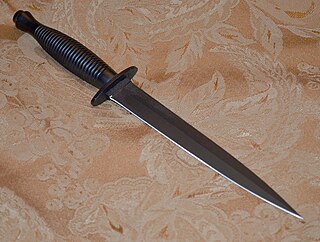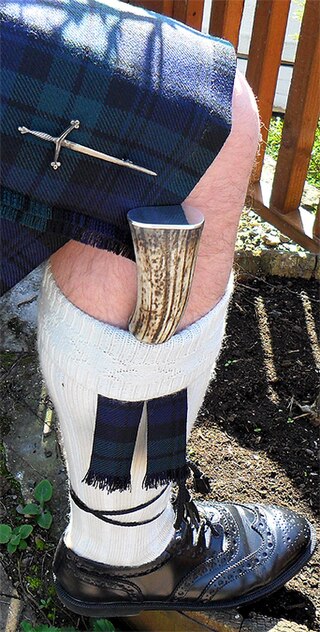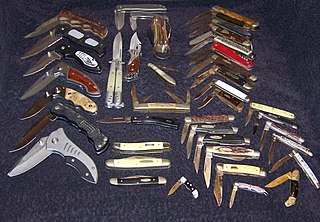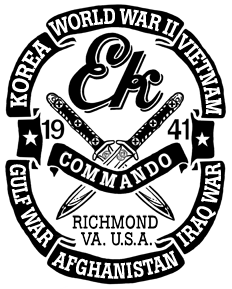
A dagger is a fighting knife with a very sharp point and usually one or two sharp edges, typically designed or capable of being used as a cutting or thrusting weapon. Daggers have been used throughout human history for close combat confrontations, and many cultures have used adorned daggers in ritual and ceremonial contexts. The distinctive shape and historic usage of the dagger have made it iconic and symbolic. A dagger in the modern sense is a weapon designed for close-proximity combat or self-defense; due to its use in historic weapon assemblages, it has associations with assassination and murders. Double-edged knives, however, play different sorts of roles in different social contexts.

A knife is a tool or weapon with a cutting edge or blade, usually attached to a handle or hilt. One of the earliest tools used by humanity, knives appeared at least 2.5 million years ago, as evidenced by the Oldowan tools. Originally made of wood, bone, and stone, over the centuries, in step with improvements in both metallurgy and manufacturing, knife blades have been made from copper, bronze, iron, steel, ceramic, and titanium. Most modern knives have either fixed or folding blades; blade patterns and styles vary by maker and country of origin.

A tantō is a traditionally made Japanese knife that were worn by the samurai class of feudal Japan. The tantō dates to the Heian period, when it was mainly used as a weapon but evolved in design over the years to become more ornate. Tantō were used in traditional martial arts. The term has seen a resurgence in the West since the 1980s as referring to a point style of modern tactical knives, designed for piercing or stabbing, though the style isn't present on any traditional tantō.

A Bowie knife is a pattern of fixed-blade fighting knife created by Rezin Bowie in the early 19th century for his brother James Bowie, who had become famous for his use of a large knife at a duel known as the Sandbar Fight.

A switchblade is a pocketknife with a sliding or pivoting blade contained in the handle which is extended automatically by a spring when a button, lever, or switch on the handle or bolster is activated. Virtually all switchblades incorporate a locking blade, where the blade is locked against accidental closure when the blade is in the open position. It is unlocked by a mechanism that allows the blade to be folded and locked in the closed position.

A balisong, also known as a butterfly knife, fan knife or Batangas knife, is a type of folding pocketknife that originated in the Philippines. Its distinct features are two handles counter-rotating around the tang such that, when closed, the blade is concealed within grooves in the handles. A latch sometimes holds the handles together; typically mounted on the one facing the cutting edge. An exceptionally large balisong is called a balisword.

The sgian-dubh – also anglicized as skene-dhu – is a small, single-edged knife worn as part of traditional Scottish Highland dress. Originally used for eating and preparing fruit, meat, and cutting bread and cheese, as well as serving for other more general day-to-day uses such as cutting material and protection, it is now worn as part of traditional Scottish dress tucked into the top of the kilt hose with only the upper portion of the hilt visible. The sgian-dubh is normally worn on the same side as the dominant hand.

A pocketknife is a knife with one or more blades that fold into the handle. They are also known as jackknives (jack-knife), folding knives, EDC knife, or may be referred to as a penknife, though a penknife may also be a specific kind of pocketknife. A typical blade length is 5 to 15 centimetres.

A trench knife is a combat knife designed to kill or incapacitate an enemy at close quarters, such as in a trench or other confined area. It was developed as a close combat weapon for soldiers attacking enemy trenches during the First World War. An example of a World War I trench knife is the German Army's Nahkampfmesser.

A jambiya, also known as a shibriyeh in the Levant, is a specific type of dagger with a short curved blade with a medial ridge that originated from Yemen. They have spread to other countries in the Middle East, to other countries in the Arab world, and to parts of South Asia and Southeast Asia. Men typically above the age of 14 wear it as an accessory to their clothing.
A combat knife is a fighting knife designed for military use and primarily intended for hand-to-hand or close combat fighting.

The Fairbairn–Sykes fighting knife is a double-edged fighting knife resembling a dagger or poignard with a foil grip. It was developed by William Ewart Fairbairn and Eric Anthony Sykes in Shanghai based on ideas that the two men had while serving on the Shanghai Municipal Police in China before World War II.

A hunting knife is a knife used during hunting for preparing the game to be used as food: skinning the animal and cutting up the meat. It is different from the hunting dagger which was traditionally used to kill wild game.

A neck knife is a knife worn on a cord hanging from a person's neck. It usually means a small fixed-blade knife which is carried by means of a cord, by which the knife sheath is suspended from around one's neck. They can either hang handle up or handle down. The knife may be hung from a loop of natural or synthetic cord, a length of braided paracord, a leather thong, or even a breakaway beaded or ball chain such as those utilized for military dog tags.

A push dagger is a short-bladed dagger with a "T" handle designed to be grasped and held in a closed-fist hand so that the blade protrudes from the front of the fist, either between the index and middle fingers or between the two central fingers, when the grip and blade are symmetrical.
Knife legislation is defined as the body of statutory law or case law promulgated or enacted by a government or other governing jurisdiction that prohibits, criminalizes, or restricts the otherwise legal manufacture, importation, sale, transfer, possession, transport, or use of knives.

Ek Commando Knife Co. or Ek Knives is an American combat knife brand produced by several different companies since the original founded by John Ek in 1941. In May 2014 the Ek brand was purchased by Ka-Bar, which began selling its versions of Ek knife designs in 2015. Although not officially issued gear, Ek Knives have seen use by US forces in six major conflicts: World War II, the Korean War, the Vietnam War, the Gulf War, both wars in Afghanistan and the Iraq War. Ek Knives manufactures Bowie-style blades, daggers, and a Fairbairn-Sykes MkII. President Franklin Delano Roosevelt, Clark Gable, and General George S. Patton have been identified as Ek knife owners.

The M3 trench knife or M3 fighting knife was an American military combat knife first issued in March 1943. The M3 was originally designated for issue to soldiers, not otherwise equipped with a bayonet. However, it was particularly designed for use by forces in need of a close combat knife, such as Airborne Units and Army Rangers, so these units received priority for the M3 at the start of production. As more M3 knives became available in 1943 and 1944, the knife was issued to other soldiers such as Army Air Corps crewmen and soldiers not otherwise equipped with a bayonet, including soldiers issued the M1 carbine or a submachine gun such as the M3 submachine gun "grease gun".
Gil Hibben is an American custom knifemaker from Wyoming who is based in La Grange, Kentucky. Hibben designed the first line of Browning hunting knives in 1968, the American Kenpo Knife for Ed Parker, and the Rambo Knife for the 1988 film Rambo III 2008 film Rambo. Hibben's "Fantasy Knives" have been used in over 37 films and television shows, particularly science fiction, earning him the title "Klingon Armorer" from the Star Trek franchise. Hibben currently serves as a President of the Knifemakers' Guild, a post he has held for fourteen years.

A fighting knife has a blade designed to most effectively inflict injury in close-quarters physical confrontations. The combat knife and the trench knife are examples of military fighting knives.

















